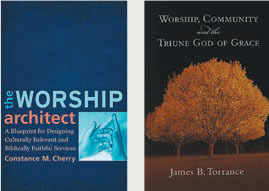How do we decide what is essential in corporate worship?
My husband and I ran into some friends who are deeply frustrated with the corporate worship culture at their church. As younger members of the congregation, they want to employ more current music. They also think it might be helpful to turn down the lights during the singing. But they are encountering resistance.
As we talked I found myself flashing back to 1980 when I watched as a church deacon, convinced rock music was of the devil, interrupted our youth service with a hammer and destroyed the drum kit of a visiting worship band. The event left no small amount of wreckage and a lasting impression.
We’ve come a long way. These days the worship wars are more like worship skirmishes. But we’re still often entrenched on opposing banks of generational and cultural divides. The turmoil is subtler, but a congregation’s capacity to worship in community remains as vulnerable to destructive forces as that doomed drum kit.
There are some tricky factors when it comes to the role singing plays in corporate worship. Music is a powerful expression of culture, and culture is largely unconsciously assumed. As a result we spiritualize our preferences believing the Holy Spirit is more able to work within a style we connect with easily.
So how do we get past the tyranny of preference? How can we evaluate our corporate worship on the basis of something other than familiarity, association or unexamined cultural assumptions?
What if we could temporarily table the questions of form and style and ask ourselves what, exactly, is the purpose of our worship? What if the question after each service was not, "Did people like the worship today?" but, "Did we fulfill our purpose as God’s worshippers this morning?" Might that completely move the goalposts?
Dr. Daryl Busby and I once worked to craft our own list of worship essentials for a course at ACTS Seminary. We noted, first, that true worship is centred in God’s acts in history – it tells God’s story. After a service we might ask, "Did our worship help us remember what God has done and is doing?"
Second, true worship is a God-initiated dialogue of revelation and response. A service that is all revelation may render us too passive, while a service that is all response may render us self-driven and exhausted. So, we might ask, "Was the beauty and wonder of God revealed to us through the reading, singing, preaching and treasuring of His Word? Were we open (perhaps even through a time of silent listening) to the immediate witness of His Spirit? And were there times we could respond to that revelation – through singing both joyful and sorrowful, through confession and through prayer?"
Third, true worship is profoundly Trinitarian and profoundly Christocentric. If someone printed out all the lyrics we’ve sung over the past month, would that person discover all three persons of the Trinity? Would the pre-eminent role of Jesus as our high priest and worship leader (Hebrews 10:10–12) come into view?
Fourth, true worship must be participatory and communal. All churches have a liturgy (formal or informal), and liturgy means the "work of the people." Worship has been truly communal when the congregation has done the work of telling God’s story, responding to His revelation and magnifying all three persons of the Trinity.
Here is where factors of form and style come into play. During times of corporate singing, is the congregation actually singing? If not, we must systematically adjust the variables (lower or higher keys, more or less volume, lights up or lights down, newer or older songs) until they do.
When our frustrated friends said they wanted to turn the lights down during worship, I was biting my tongue. In my experience to do so is to signal passivity to the congregation. And yet my daughter tells me the dimmed lights at the youth services she attends reduce self-consciousness and encourage participation. It turns out if true worship is communal, that means it’s also contextual.
So what would happen if our frustrated friends could sit down with their church leadership and prayerfully craft their own list of worship essentials? Maybe then they would discover both the freedom and mandate to experiment over time, hammering out – gently and redemptively – the way their particular people, in their particular time and place, are called to participate in God’s story together.

.jpg?lang=en-US)
Carolyn Arends (www.carolynarends.com) is a recording artist, author and director of education for Renovaré. Find more of these columns at www.FaithToday.ca/GoWithGod.